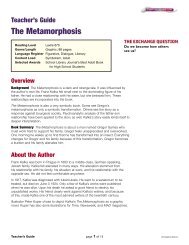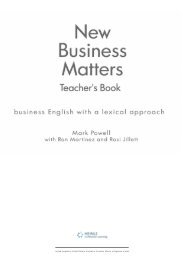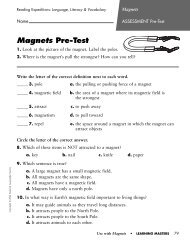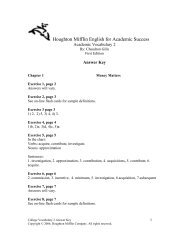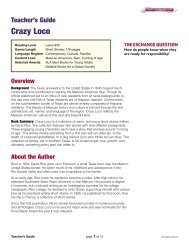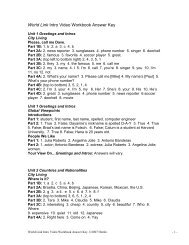English for Cabin Crew Trainer's Guide - Heinle
English for Cabin Crew Trainer's Guide - Heinle
English for Cabin Crew Trainer's Guide - Heinle
Create successful ePaper yourself
Turn your PDF publications into a flip-book with our unique Google optimized e-Paper software.
UNIT<br />
1 The pre-fl ight briefi ng<br />
LEAD IN Speaking<br />
Ask students, Which people attend a pre-fl ight briefi ng? Where<br />
does it usually take place? What in<strong>for</strong>mation do you fi nd out? Tell<br />
students to imagine they are about to have a pre-fl ight briefi ng.<br />
Ask them to work in pairs to think of questions to ask to fi nd out<br />
in<strong>for</strong>mation at the briefi ng. Elicit questions from the pairs and<br />
write them on the board. Decide as a class which are the most<br />
useful questions.<br />
Meeting colleagues<br />
Pre-teaching vocabulary<br />
Check the following key words: briefi ng (short meeting at which you get<br />
in<strong>for</strong>mation); shuttle (train that goes from one terminal to another at<br />
an airport); roster (timetable that says when you are working); turbulent<br />
(when winds make the plane move up and down); off sick (not working<br />
because you are ill); long-haul (long distance).<br />
EXERCISE 1 Listening<br />
Give students time to read through the situation and questions and<br />
discuss them in pairs be<strong>for</strong>e playing the recording. You could ask<br />
students if they can guess what Paola, Tom and Jenny say in answer<br />
to questions 2, 3 and 4. Play the recording. Students listen and then<br />
discuss their answers in pairs. Get feedback in open class at the end.<br />
Answers<br />
1 Boston 2 ‘My name’s Paola, by the way.’ 3 ‘Hi, Paola. I’m Tom. It’s nice<br />
to meet you.’ 4 ‘Sorry, what’s your name?’ 5 They are not sure. Possibly.<br />
6 in ten minutes’ time<br />
EXERCISE 2 Listening<br />
Give students time to read through the situation and questions. Ask<br />
students to discuss the questions in pairs be<strong>for</strong>e playing the recording.<br />
Play the recording. Students listen and then discuss their answers in<br />
pairs. Get feedback in open class at the end.<br />
Answers<br />
1 F – they greet each other by name.<br />
2 F – ‘We’ve met be<strong>for</strong>e.’<br />
3 T<br />
4 F – she wants to do some shopping there.<br />
5 T<br />
6 F – it was Jenny who spilled the drinks.<br />
7 F – Katrin isn’t.<br />
EXERCISE 3 Listening<br />
Give students time to read through the situation and questions. Ask<br />
students to discuss the questions in pairs be<strong>for</strong>e playing the recording.<br />
Play the recording. Students listen and then discuss their answers in<br />
pairs. Get feedback in open class at the end.<br />
Answers<br />
1 Ted 2 in Business 3 in Economy 4 It’s her fi rst long-haul fl ight.<br />
5 Leila and Hemal 6 at Door 4 Left<br />
INTRODUCTIONS Language focus<br />
Give students time to read through the phrases in the box. Alternatively,<br />
read out the phrases and ask students to read and follow. Ask students,<br />
Which phrases are more <strong>for</strong>mal? (Pleased to meet you, Could you tell me<br />
your name, please? and This is my colleague are more <strong>for</strong>mal.)<br />
EXERCISE 4 Pronunciation<br />
Play the recording. Ask students to listen and repeat.<br />
Pronunciation notes<br />
It is important to use a wide intonation pattern in <strong>English</strong> when<br />
introducing yourself in order to sound friendly and polite. Make sure<br />
students attempt a wide intonation pattern.<br />
➚➘<br />
Pleased to meet you.<br />
➚➘➚ ➚➘ ➚<br />
Excuse me, could you tell me your name, please?<br />
➘ ➚<br />
Fine thanks. And you?<br />
EXERCISE 5 Speaking<br />
A good way of organizing this is to ask students to sit with a colleague<br />
they have never met or don’t know very well, and tell them to introduce<br />
themselves. Then ask each pair to join with a new pair. They must<br />
now introduce their colleague to the other pair. If the cabin crew in<br />
your group all know each other, tell them to pretend. As students<br />
are practising, walk round, listen, and prompt students to use good<br />
pronunciation. At the end, praise any good examples of language use and<br />
correct any errors you heard.<br />
EXERCISE 6 Speaking<br />
Check the vocabulary by asking students to label the items in the<br />
pictures. Ask students to work in small groups to discuss which items<br />
they take. Get feedback in open class.<br />
ROUND UP<br />
Write NAME, NATIONALITY, AIRLINE on the board. Then tell<br />
students to invent a false identity (<strong>for</strong> example, I’m William,<br />
I’m Scottish, and I work <strong>for</strong> BA). Tell the students to stand up,<br />
walk round, and introduce themselves to each other. Tell them<br />
they have to meet everybody and remember as many names as<br />
they can. At the end, ask two or three students to introduce fi ve<br />
people to the class, using the imaginary names and nationalities.<br />
This extends exercise 5 and provides further practice of the<br />
language of the unit.<br />
5



